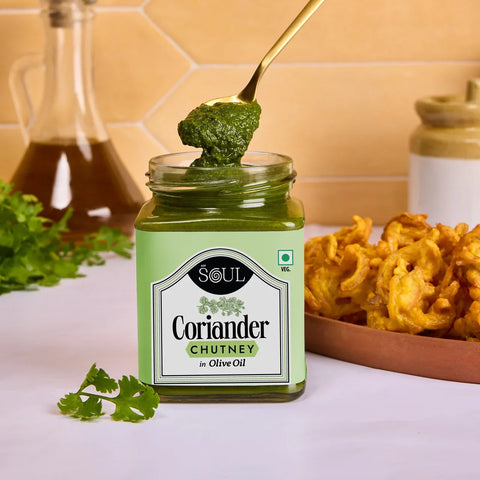In the world of clean, conscious eating, ragi dosa benefits stand tall for their blend of nutrition and flavor. This crisp, earthy dosa made from finger millet flour is naturally gluten-free, packed with calcium, and rich in fiber. But what truly elevates it from simply healthy to wholly satisfying is what you serve alongside.
Because while a good dosa fills the stomach, only the right accompaniments bring soul to the plate—and that’s exactly where ADF Soul Foods steps in. Whether you’re making a ragi instant dosa or going traditional with fermentation, the experience feels incomplete without the brand’s handcrafted pickles and chutneys in cold-pressed olive oil.
Let’s dive deep into everything that makes ragi dosa benefits worth the hype—and why ADF makes every bite better.
Understanding Ragi Dosa: Health and Simplicity in One Dish
What Is Ragi Dosa, and Why Is It Special?
Ragi, also known as finger millet, is a super grain that's been part of Indian heritage for centuries. When turned into a crispy dosa, it delivers impressive ragi dosa health benefits—from managing weight to improving bone health.
If you’re wondering, “Can I make dosa with ragi flour?”, the answer is yes—and it’s as delicious as it is nutritious. Whether you’re preparing an instant ragi dosa batter or opting for a fermented recipe, the outcome is a versatile, health-forward dish perfect for any meal.
Ragi Dosa Health Benefits That Make It a Daily Essential
Here’s why you’ll want to make ragi a staple:
-
High Calcium & Iron Content: Supports bone strength and combats fatigue.
-
Rich in Fiber: Promotes digestion and keeps you fuller longer.
-
Low Glycemic Index: Ideal for blood sugar management.
-
Gluten-Free: Suitable for celiac or gluten-intolerant individuals.
-
Aids in Weight Management: Low in calories and high in nutrients.
Can we eat ragi dosa daily?
Absolutely! Especially when served with gut-friendly accompaniments like those made by ADF Soul Foods, it becomes a sustainable, daily go-to.
Ragi Dosa Recipe: How to Make It Step by Step
Ingredients for Ragi Dosa Batter (Instant Version):
-
1 cup ragi flour
-
¼ cup rice flour
-
¼ cup curd (optional, for light sourness)
-
1 finely chopped onion
-
2 chopped green chillies
-
1 tsp cumin seeds
-
Salt to taste
-
Water as required for thin batter
-
Olive oil for cooking
Steps:
-
Mix ragi flour, rice flour, curd, and salt in a bowl.
-
Add onions, green chillies, cumin, and water to make a thin batter.
-
Let the ragi dosa batter rest for 15–20 minutes.
-
Heat a non-stick pan and spread the batter like a regular dosa.
-
Drizzle olive oil around edges, cook until crisp, and serve hot.
This ragi instant dosa is not only quick and healthy but also the perfect canvas for flavor-packed accompaniments.
Is Ragi Dosa Healthier Than Normal Dosa?
Yes—and here’s why:
-
Ragi has three times more calcium than rice.
-
It is naturally rich in iron, helping fight anemia.
-
It has fewer calories than rice or maida-based dosas.
-
It supports longer satiety, making it perfect for weight control.
Pairing it with ADF Soul Foods’ chutneys or pickles gives the dish probiotic depth, extra spice, and a gourmet feel—especially since their products are made in olive oil, preserving all the nutrients and adding healthy fats.
Ragi Dosa Calories: What to Expect
Watching your intake? Here’s a general guide:
-
Plain ragi dosa (1 medium): ~90 calories
-
With toppings or oil: ~120–130 calories
-
When served with ADF pickles or chutneys in olive oil: ~140–150 calories (and worth every bite!)
Fermented vs Instant: Is Ragi Dosa Fermented?
Is ragi dosa fermented? It can be!
-
Instant ragi dosa uses no fermentation—quick, easy, and still nutritious.
-
Traditional fermented ragi dosa includes urad dal for softness and probiotic boost.
Both styles taste even better with thoughtfully paired sides, which we’ll explore next.
Pairing Options That Complete the Ragi Dosa Experience
Your dosa isn’t complete without something bold and flavorful. With ADF Soul Foods, you get both variety and quality—all prepared in cold-pressed olive oil for added health benefits.
Best Pickles for Pairing:
-
Garlic Pickle in Olive Oil – For bold, spicy bites
-
Mango Pickle in Olive Oil – Adds a sweet-sour contrast
-
Red Chilli Pickle in Olive Oil – Brings serious heat
-
Lime Pickle in Olive Oil – Sharp and tangy
-
Carrot Pickle in Olive Oil – Crunchy and earthy
-
Green Chilli Pickle in Olive Oil – Fiery and vibrant
-
Mixed Pickle in Olive Oil – For complex, layered flavor
Top Chutneys for Pairing:
-
Garlic Chutney in Olive Oil – Deep spice and aroma
-
Mint Chutney in Olive Oil – Cool and herbaceous
-
Coriander Chutney in Olive Oil – Fresh, bright, and balanced
-
Schezwan Chilli Chutney in Olive Oil – Indo-Chinese spice kick
-
Date & Tamarind Chutney – Sweet and tangy
-
Chhundo Chutney – Sweet-savory Gujarati-style mango blend
-
Gorkeri Chutney – Mildly spiced mango delight
-
Hot Mango Chutney – Sweet-heat balance
You can choose based on mood or spice preference—but skipping the side altogether? That’s a miss.
Why Ragi Dosa Benefits Are Best Enjoyed with ADF Soul Foods
From gut health to heart health, from tradition to modern taste—ragi dosa benefits truly come alive when paired with the right sides. And ADF Soul Foods has curated a range of clean-label pickles and chutneys that do just that. With every jar made using cold-pressed olive oil, whole spices, and traditional recipes, these pairings elevate your meal from nutritious to unforgettable.
So whether you’re enjoying a fermented version or a quick ragi instant dosa, don’t forget to complete it with a spoonful of ADF’s best.
FAQs About Ragi Dosa Benefits and More
1. Can we eat ragi dosa daily?
Yes, it’s a great daily choice when paired with nutritious sides like ADF’s olive oil-based condiments.
2. Is ragi dosa healthier than normal dosa?
Definitely. It’s richer in calcium, iron, and fiber, and lower in glycemic load.
3. How to make ragi dosa step by step?
Mix ragi and rice flour with water and seasonings, rest, and cook on a hot pan. Use olive oil for extra health benefits.
4. Can I make dosa with ragi flour?
Yes. That’s the base for ragi instant dosa, perfect when you’re short on time.
5. Is ragi dosa fermented?
It can be either fermented or instant. Both have their benefits, and both pair well with ADF Soul Foods’ chutneys or pickles.
6. What are ragi dosa calories?
Plain dosa has 90–100 calories. With sides and oil, it ranges up to 140–150 depending on quantity.
7. Which chutney is best with ragi dosa?
Garlic Chutney in Olive Oil or Mint Chutney from ADF are crowd favorites.
8. Can kids eat ragi dosa?
Yes, it's high in calcium and iron—great for growing children, especially when served with mild chutneys.
9. Does ragi dosa aid in digestion?
Yes. It’s rich in fiber, and ADF’s condiments further help with digestion due to their probiotic content.
10. Is olive oil good for dosa?
Yes. It’s heart-healthy and helps retain the nutrients in both dosa and its sides.


